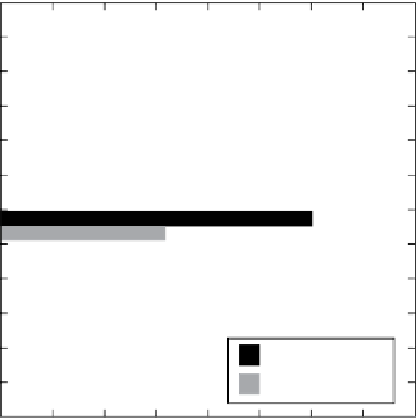Geology Reference
In-Depth Information
(a)
(b)
Chondrites
Unequilibrated chondrites
R
EL
R
EL3
EH
K
EH3
CV
CO3
CO
CM
CK3
CK
CR
CB
CV3
CR3
ANSMET
Non-ANSMET
CH
ANSMET
Non-ANSMET
CI
CR1
0 0 00
150 200
Number meteorites
250
300
350
400
0
50
100
150
200
250
Number meteorites
(c)
(d)
Type 7 and melt rocks
Unequilibrated H, L, LL chondrites
LL-melt
ANSMET
Non-ANSMET
LL3
L-melt
H-melt
L3
LL7
ANSMET
Non-ANSMET
H3
L7
0 0 0 0 0 0 0 0 0
Number meteorites
0 00
200
300
400
500
600
700
800
Number meteorites
Figure 4.1.
(a) Histogram showing the total number of ANSMET vs. non-ANSMET meteorites in the carbonaceous, enstatite, K,
and R chondrite classes. (b) Histogram showing unequilibrated Antarctic vs. non-Antarctic meteorites in carbonaceous, enstatite,
and R chondrite groups. The only known CR3 and CR1 chondrites are from the ANSMET collection. The majority of EL3
chondrites are also from, and the group is largely defined by, meteorites in the ANSMET collection. (c) Histogram showing
ANSMET vs. non-ANSMET type 3 ordinary chondrites. (d) Histogram of ANSMET vs. non-ANSMET ordinary chondrite type
7 s and melt rocks. Data were compiled from the Meteoritical Society's Meteoritical Bulletin Database (
http://www.lpi.usra.edu/
meteor/metbull.php
). Numbers include all Antarctic meteorites and their paired samples. Although all paired samples are
included, the ANSMET meteorites are represented in all chondrite groups and in some cases greatly exceed the number of non-
ANSMET members, for example, CMs. This is particularly important for a group like the CM that span a wide range of aster-
oidal alteration conditions. (Note: the non-ANSMET data include Antarctic meteorites from other collections, specifically from
the National Institute of Polar Research (NIPR), Tokyo)











